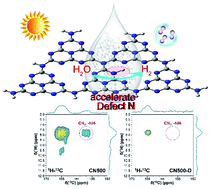Selective hydrogen–deuterium exchange in graphitic carbon nitrides: probing the active sites for photocatalytic water splitting by solid-state NMR†
Abstract
The relationship between the structural characteristics and photocatalytic reaction mechanisms of graphitic carbon nitride (g-C3N4) still remains unclarified at the molecular level, which severely hinders the further development of this field. The present study addresses this issue by employing an innovative strategy to investigate the relationship between the H-containing structures of g-C3N4 and its water splitting properties. The exchangeable and unexchangeable protons of the H-containing groups of g-C3N4 were differentiated by selective deuteration, providing a way to distinguish the hydrophilic and relatively non-hydrophilic H-containing groups of g-C3N4. A combination of advanced solid-state NMR approaches reveals that amino group defects (CN2(NHx)) on the C–N skeleton of the photocatalyst likely serve as hydrophilic active sites for facilitating the photocatalytic hydrogen evolution reaction. Accordingly, the newly synthesized g-C3N4 sample having a high concentration of CN2(NHx) by design demonstrates an enhanced H2 yield by a factor of 17 compared to that of pure g-C3N4.

- This article is part of the themed collection: Journal of Materials Chemistry A HOT Papers


 Please wait while we load your content...
Please wait while we load your content...